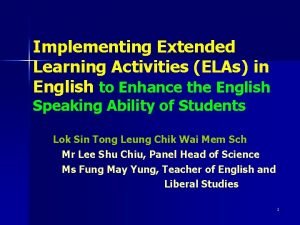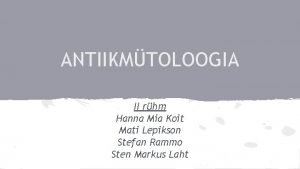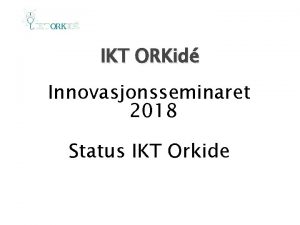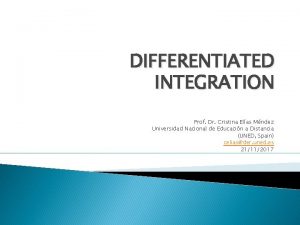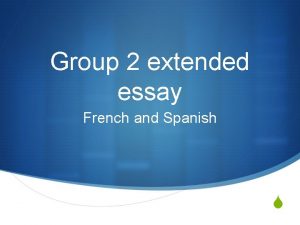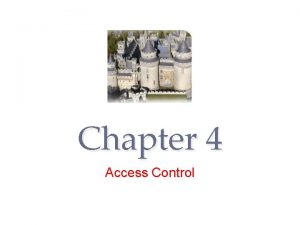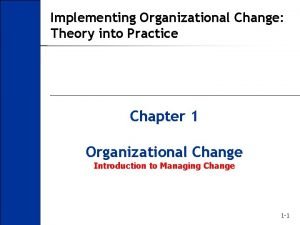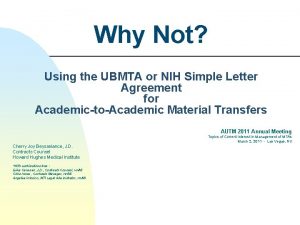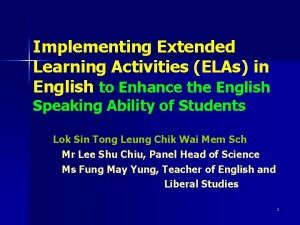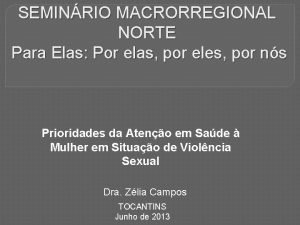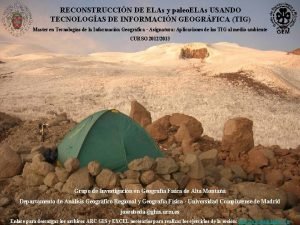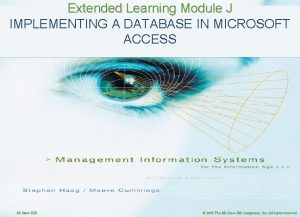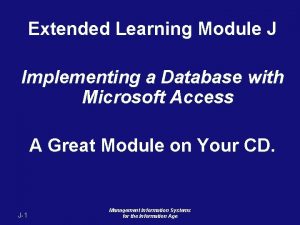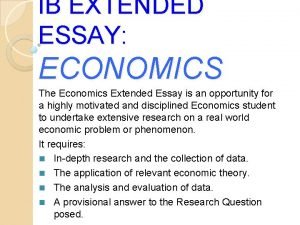Implementing Extended Learning Activities ELAs in English to


































- Slides: 34

Implementing Extended Learning Activities (ELAs) in English to Enhance the English Speaking Ability of Students Lok Sin Tong Leung Chik Wai Mem Sch Mr Lee Shu Chiu, Panel Head of Science Ms Fung May Yung, Teacher of English and Liberal Studies 1

Outline of Presentation 1. School Background 2. Video Shows on ELA 3. Rationale 4. Action Research: Plan-Implement-Evaluate (PIE) Framework u Planning u Implementation u Evaluation 5. Way Forward 2

School Background n CMI School – Enhance English Proficiency while capitalize mother-tongue teaching n ESR report in 2005/2006 – Enhance school English-learning environment Improve students’ proficiency and confidence n One NSS Class using EMI in Science – Students lack confidence to communicate in English in lessons 3

A Video Show on ELA in Integrated Science n n A S 1 Integrated Science Lesson Topic: Energy Changes What are the features and focus of ELA? 4

Whole Class Pair. Medium of Instruction: Work Speaking Wholly in English ? Activity ? Stronger Students’ Demonstration on Pair-Work School-based Speaking Activity Students’ ? Worksheets ? Teachers’ Demonstration on Pronunciation ? Pair-work Speaking Activity? Features ! 5

Features and Focus of ELA Pronunciation Focus Whole Class Pair-Work Speaking Activity Students’ Speaking Ability Stronger Students’ Demonstration on Pair-Work Speaking Activity Teachers’ Demonstration on Pair-work Speaking Activity 6

Rationale 1. Education Reform – “Every student is provided with the opportunity to develop their English proficiency, which is prerequisite for life-long learning” (Curriculum Development Council, 2001) (Public Level) 2. Parents’ Expectation - English is a very important language for their children to be successful in the future (Parent Level) 3. ESR Report 2005/2006 - Improve students’ English proficiency and confidence (School Level) 4. Increase English ability of the students promoted to NSS EMI science class (Subject Level) 7

Opportunities 1. “schools adopting Chinese as the MOI at junior secondary levels may, on top of language lessons, choose to allocate not more than 15%, 20% and 25% of the total lesson time at S 1, S 2 and S 3 respectively in a progressive manner for conducting extended learning activities (ELAs) in English. ” (Education Commission, 2005, p. 69) 2. Study on Conducted Extended in English Learning in Activities Chinese-medium Schools in Hong Kong from 2007 to 2010 by The Open University of Hon Kong 3. Fine-tuning the Medium of Instruction for Secondary Schools (2010/2011) 8

Objectives 1. Improve the students’ English proficiency especially in their speaking skill 2. Boost the confidence of the students of New Senior Secondary EMI classes in communicating in science lessons 3. Modify the curriculum design and suggest better pedagogy to suit the needs of the students 9

Action Research: P-I-E Framework Objectives u Curriculum design u Course work design Plan u Pedagogy u Assessment u Teachers’ Capabilities and Confidence Students’ Learning Outcomes u Questionnaires u Pre-S 1 HKAT u TSA (S 3) u HKDSE (S 6) u Integrated Science Evaluate Implement u Liberal Studies u Mathematics 10

Planning – Curriculum Design n Selected topics – about one period per cycle Topics (Integrated Science) Rhetorical Functions Apparatus Describing Bunsen burner Experimenting (Sequencing), Comparing Animals Describing, Classifying Energy Changes Classifying, Defining States of Matter Change of States Classifying, Exemplifying Cause and Effect Air, Tests for Gases Describing, Classifying, Giving Evidence, Predicting Circuit Components Describing 11

Planning - Motivation Theory Students’ Selfefficacy* Confidence Self-efficacy is an essential belief to drive one’s willingness to actively take part in learning. (Stipek, 2002, p. 75) Students’ Success Social factors – Human Relationship , Environment 12

Planning – Course Work Design Clear instruction, appropriate tasks Questions with similar language types Guided and progressive learning approach Appropriate tasks Photos 13

Planning – Course Work Design Features Effects Content taught in mother tongue Avoid preprocessing in learning new subject content reduce anxiety, not to undermine motivation Clear instruction, appropriate task Easy to follow reduce anxiety Pictures and photos Avoid preprocessing in learning new content in English reduce anxiety, not to undermine motivation Guided and progressive learning approach, questions with similar language types Strengthen ability through repetition and practice, provide actual experience build confidence , raise self-efficacy, enhance motivation 14

Planning – Pedagogy Features Targets of English proficiency Pronunciation Listening and speaking skills Teachers’ and stronger students’ demonstration on pair-work speaking task Listening skill Whole class pairwork speaking activity Listening and speaking skills 15

Planning – Assessment Feature Target 15% allocated in Test and Exam Students’ performance 16

Planning – Teachers’ Capabilities and Confidence Features Effects Voluntary in conducting a whole lesson completely in English Not adversely affected teaching effectiveness Confidence in conducting a whole lesson completely in English Enhance teaching effectiveness 17

Implementation - Strategy n “Teachers allocate some of the lesson time for individual content subjects or cross-curricular subjects during which they would use EMI to go through the relevant concepts and contents that have been taught through the mother tongue. The revision can also be supplemented with a variety of illustration or other learning activities. ” (Education Commission, 2005, pp. 71 -72) 18

Implementation - Motivation Theory Students’ Selfefficacy* Confidence Self-efficacy is an essential belief to drive one’s willingness to actively take part in learning. (Stipek, 2002, p. 75) Students’ Success Social factors – Human Relationship, Environment 19

Implementation – Motivation Theory Elements of Motivation Teacher’s Support on Students Effects Actual experience on pronunciation Build confidence and raise self-efficacy by increasing experiences in successes but decreasing experiences in failures Self-efficacy Vicarious experiences on teachers’ and stronger students’ demonstration on pair-work Raise self-efficacy by observing tasks completed successfully by teacher and peers Positive human relationship Encourage participation through praise and care from teachers and support from classmates Whole class pair-work Create non-threatening learning environment to 20 minimize anxiety Social factors

Implementation - Another video show on ELA in Liberal Studies n n A S 1 Liberal Studies Lesson Topics: – Tourist Attractions in Hong Kong – Traditional Villages in the New Territories n Focus: – Q&A 1 2 3 4 5 6 7 8 9 10 --- – Vocabularies – Pronunciation – Grammar – Pair work 21

Evaluation n Findings – By analyzing Pre-S 1 HKAT and S 3 TSA results, English proficiency was improved and more profound improvement was found for speaking skill (Objective 1) – About % of the students thought that ELA could raise their confidence in speaking and communicating in English (Objective 2) – The degree of students’ interest in participation in ELA was diverse. This provided insight to design worksheet and teaching strategies to cater for the students’ diversity both in English and subject content. For instances, more challenging tasks should be included for the better students while easier and more supportive ones for the weaker. (Objective 3) 22

Evaluation n n Cohorts: 06/07, 07/08, 08/09 Data Collection and Feedback – Students’ Questionnaires – Students’ Pre-Secondary One (Pre-S 1) Hong Kong Attainment Tests (HKAT) results – Secondary Three (S 3) Territory-wide System Assessment (TSA) results – Participating Teachers’ Views 23

Evaluation n Evaluation Tool – Students’ Questionnaire Question Performance assessed Response (Likert scale) 1 My learning in English Language lesson is enhanced. 2 My English standard is raised. 3 I understand the teaching content. Listening skill My confidence in answering teacher’s questions in English orally is increased. My communication skill in English is improved. Speaking skill Listening and speaking skill 6 I actively participate in the activities in lesson. Interest in participating in ELA 7 ELA should also be implemented in Secondary Two. The teaching time of ELA should be increased. 4 5 8 English proficiency 5 = Strongly Agree, 4 = Agree 3 = Neither Agree Nor Disagree 2 = Disagree 1 = Strongly Disagree 24

Evaluation n Findings about English Proficiency Questions Range of Average Strongly Scores for S 1 Agree/Agree for S 1 Disagree/Disagree for S 1 06/07 07/08 08/09 My learning in English Language lesson is enhanced. My English standard is raised. I understand the teaching content. – Average score: – Strongly agree or agree: – Strongly disagree or disagree: – This suggested that ELA could improve their English proficiency. 25

Evaluation n Findings about communication skill Questions Level Range of Average Strongly Scores Agree/Agree 06/07 07/08 08/09 My confidence in orally answering teacher’s question in English is increased. My communication skill in English is improved. S 1 S 2 – Strongly agree or agree: – Mean of Strongly disagree or disagree: – About % of the students thought that ELA could raise their confidence in speaking and communicating in English. – They will be confidence in learning in science using EMI in a NSS class 26

Evaluation n Findings about interest in participation Questions Level Range of Average Strongly Scores Agree/Agree Disagree/Disagree 06/07 07/08 08/09 I actively participate in the activities in lesson. ELA should also be implemented in Secondary Two. S 1 The teaching time of ELA should be increased. S 1 S 2 S 2 – Strongly agree or agree: – Strongly disagree or disagree: – The degree of students’ interest in participation in ELA was diverse. This provided insight to design worksheet and teaching strategies to cater for the students’ diversity both in English and subject content 27

Evaluation n VA – Value. Addedness Evaluation Tool – Pre-S 1 HKAT and TSA results Cohort Pre-S 1 HKAT Percentile for English Language S 3 TSA % of students achieving Basic Competency for English Language / Speaking (Individual) / Speaking (Group) / School Difference compared with all students in Hong Kong School HK Difference compared with all students in Hong Kong S 1* HKAT= (S 150)/50# S 3* P* TSA = (S 3 P)/P# 05/06 (no ELA implemented) S 3 VA: TSAHKAT S 6 HKDSE Passing % VA S 3 VA=TSA – HKAT# 06/07 (ELA implemented) * - Numerical data (S 1, S 3, P) # - Equation 28

Evaluation n n Evaluation Tool – Pre-S 1 HKAT and TSA results Findings about English Proficiency and Speaking Skill: – S 3 VA = S 3 TSA – Pre-S 1 – S 3 VA for 06/07 (with ELA implemented) showed a greater value than that of 05/06 (no ELA implemented) for English Language, Speaking (Individual) and Speaking (Group) in S 3 TSA – A more significant improvement was obtained for Speaking for both Individual and Group 29

Evaluation n Other Evaluation Tools – S 4 and S 6 Students’ Questionnaires, S 6 HKDSE, S 6 Value-addedness (VA) – A sample of composition of a S 6 student’s in 2012 HKDSE Mock Paper (Student Learning Outcome) Question: You are a member of the school debating club. Your club is entering a debating contest and the motion is Nuclear power is the best source of energy for the future. Decide whether you are for or against the motion and write your debate speech. The members with the best speeches will be chosen to represent the school at the competition. 30

Evaluation n Discussion – Confounding factor: English Enhancement Scheme – Critical factors: l Teachers’ English capability and confidence (Implementation) l Panel Chairpersons’ experience in curriculum planning and leadership capacities (Planning and Evaluation) l Teachers’ lifelong learning attitude equip with necessary knowledge and experience through Professional Development prerequisite for Action Research (Plan – Implement – Evaluate – Reflect) 31

Way forward u Identify problems and/or ways of improvement to start another P-I-E cycle: reading for information, more emphasis on writing skill, cater diversity - challenging task for more able and peer support for less able, consolidation in NSS classes u Holistic approach Collaborative work across curriculum with English Panel u No quick fixes u Need genuine conversation with and collect views from different stakeholders such as students, teachers, principal, parents and external expertise 32

References Curriculum Development Council. (2001). Learning to learn: life-long learning and whole-person development. Hong Kong: Printing Department. Education Commission. (2005). Report on review of medium of instruction for secondary schools and secondary school places allocation. Hong Kong: Government Logistics Department. Stipek, D. (2002). Motivation to learn: Integrating theory and practice (4 th ed. ). Boston: Allyn & Bacon. 33

Q&A 34
 Extended learning activities
Extended learning activities Elas rosario
Elas rosario Daidalose poeg
Daidalose poeg Ubc elas
Ubc elas Visma orkidé
Visma orkidé Elas rosario
Elas rosario Elas rosario
Elas rosario Cuadro comparativo e-learning y b-learning
Cuadro comparativo e-learning y b-learning The statement of cash flows helps users
The statement of cash flows helps users In these activities
In these activities Support activities and primary activities
Support activities and primary activities Examples of primary activities
Examples of primary activities Extended essay english b categories
Extended essay english b categories Implementation of hrd program
Implementation of hrd program Chapter 7 strategic management
Chapter 7 strategic management Strategic management chapter 7
Strategic management chapter 7 Implementing strategies: management and operations issues
Implementing strategies: management and operations issues Setting prices and implementing revenue management
Setting prices and implementing revenue management Implementing merchandise plans
Implementing merchandise plans Designing and implementing brand marketing programs
Designing and implementing brand marketing programs Designing and implementing brand architecture strategies
Designing and implementing brand architecture strategies Portfolio assessment matches assessment to teaching
Portfolio assessment matches assessment to teaching Crm project design and planning process
Crm project design and planning process Group dynamics examples
Group dynamics examples Challenges of implementing predictive analytics
Challenges of implementing predictive analytics Implementing organizational change spector
Implementing organizational change spector Mis issues in strategy implementation
Mis issues in strategy implementation Access rights definition
Access rights definition Simplified scoring model in project management
Simplified scoring model in project management Strategic business unit structure
Strategic business unit structure Flanker brand strategy
Flanker brand strategy Nfpa 1600 standard
Nfpa 1600 standard Implementing organizational change theory into practice
Implementing organizational change theory into practice Ubmta implementing letter
Ubmta implementing letter Implementing nfpa 1600 national preparedness standard
Implementing nfpa 1600 national preparedness standard
